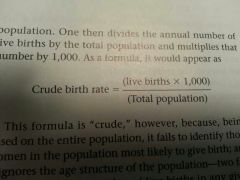![]()
![]()
![]()
Use LEFT and RIGHT arrow keys to navigate between flashcards;
Use UP and DOWN arrow keys to flip the card;
H to show hint;
A reads text to speech;
17 Cards in this Set
- Front
- Back
- 3rd side (hint)
|
demography
|
the scientific study of population, encompasses all measures of population: size, distribution, composition, age structure, and change.
|
|
|
|
demography: 2 subareas:
|
1. formal demography: deals with gathering. collating, analyzing and presenting population data
|
|
|
|
demography: 2 subareas:
|
2. social demography: the study of population patterns within a social context.
|
|
|
|
3 population processes
|
1. fertility
2. mortality 3. migration |
|
|
|
1. Fertility:
|
measures the number if children born to a woman or to a population of women.
|
actual # of children women produce
|
|
|
Fecundity:
|
is the max. rate at which women can potentially produce children.
|
hutterites
natural fertility: # of children born in the absence if conscious birth control |
|
|
Crude birth rate:
|
the annual # of live births per 1,000 members of a population
to calculate birth rate, one simply needs to know the # of births in a year and the size if the population. |

varies from one country to another
us= 14 to 1,000 |
|
|
2. Mortality
|
deaths w/in a pop.
1. life span 2. life expectancy |
|
|
|
life span
|
the most advanced age to which humans can survive
|
|
|
|
life expectancy
|
avg. number if yrs. that persons in a given pop. born at a particular time can expect to live.
|
|
|
|
morbidity
|
refers to rates if diseases and illness in a pop.
|
|
|
|
how is mortality measured?
|
1. crude death rate: the annual # of deaths per 1,000 members or a pop.
|
figured by dividing the annual # of deaths by the total population and mult. by 1,000
|
|
|
how is mortality measured?
|
2. age-specific death rates: to measure the # of deaths per 1000 persons in a specific age group
|
|
|
|
how is mortality measured?
|
infant mortality rate: the # of deaths among infants under one year of age per 1000 live births
|
|
|
|
3. Migration:
|
refers to the movement of people from one geographical area to another for the purpose of establishing s new residence.
|
|
|
|
how is migration measured?
|
1. gross migration rate: the # of persons per 1000 members of a pop who, in a given year, enter (immigrants) or leave (emigrants) a geographical area
|
|
|
|
how is migration measured?
|
2. net migration rate: is the annual increase or decrease per 1000 members of a pop. resulting from movement into and out of the pop.
|
|

